Spanning various divisions of the Dentsu Group in Japan, Mirai Jigyo Soken (literally, future business creation research) is an organization that helps companies create businesses and spark innovation by envisioning their future.
In 2023, Mirai Jigyo Soken organized a half-day workshop that included nine high school students. Held in Shibuya, a trendsetting area of Tokyo popular with young people, the event was held in collaboration with Toppan Inc. and Shibuya 109 Lab. Toppan is a Japanese manufacturer and content creator that applies a wide range of technologies and expertise to its work, while 109 Lab is a marketing organization that targets young consumers and specializes in matters related to Generation Z.
During the workshop, the students were asked to envision the future and, as they did so, Mirai Jigyo Soken identified their concerns about the future and major changes in their awareness, before analyzing the underlying reasons for those changes.
While today’s high school students will go on to play roles in society, many are anxious about the future. Nevertheless, there are technologies that can help change the future for the better, and many are owned by companies that engage in business-to-business (B2B) transactions, which high school students rarely have opportunities to encounter. By making students aware of this, it may help them to shift their anxiety towards the future to ‘a bit of fun’. That was the starting point for the workshop.
In this installment of Showcase, Mirai Jigyo Soken member Akane Yamada shares the ideas that the nine high school students came up with in the workshop, and explains how to become involved with such companies in the future.
About Mirai Jigyo Soken
As an inter-divisional organization of the Dentsu Group companies in Japan, this company supports initiatives by organizations to create businesses and spark innovation by envisioning their future. It seeks to create communities that inspire their youth to look forward to the future, and works with corporate clients to envision an ideal tomorrow, while helping them take the initial steps toward realizing such a future.
B2B technologies + high school student views
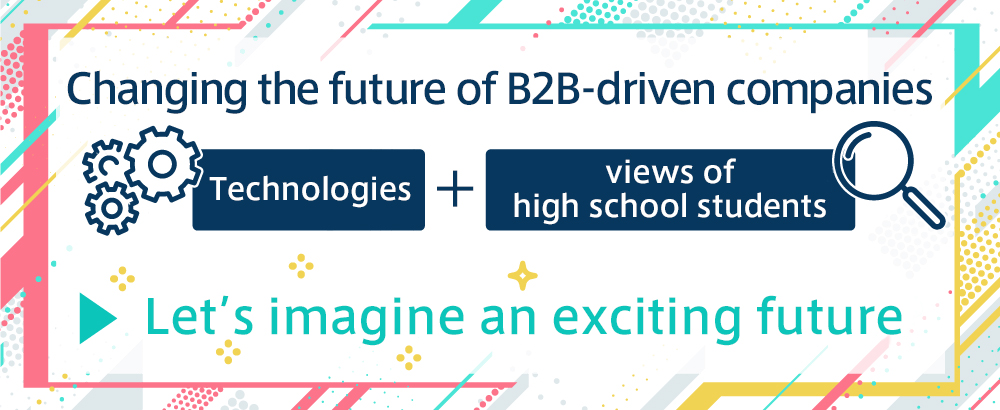
Our workshop on imagining the future was arranged in three stages. First, we identified what made the high school students anxious about the future. Second, we introduced technologies and related initiatives that were being promoted by Toppan. Finally, we had the students tell us about the future they hoped to create. To encourage them to think about such a future, we asked the students to come up with ideas for social media that could help spread happiness around the world.
The nine students came up with concrete ideas, giving us a clear sense of what their concerns were about the future. I discuss these points in more detail below.
Let’s starting with ideas for social media that might spread happiness.
We had put some thought into asking the students to think about such ideas. We focused on social media because high school students regard them as essential communication tools. Not only are the services embedded in their lives, but they are becoming increasingly diverse as the internet and globalization expand.
But, in the future, how will social media evolve as AI and the metaverse continue to spread, and how will information be collected and accessed? We had the students think about that future with a team from Toppan, Shibuya 109 Lab, and Mirai Jigyo Soken.
During the workshop, the students and team members were divided into two groups. Considering various technologies presented to them, they were asked to envision ideas for a future they hoped to create.
The students were asked to write down their concerns about the future and social media; to discuss issues they faced at that time; and what they thought they could do to deal with those issues. They were encouraged to think deeply about how those solutions might be made possible, what obstacles might arise, how those things related to the future they hope to create, and what they truly wanted to do.
Next, the members from Toppan gave presentations on a number of the company’s products and technologies, and discussed their potential for helping realize what the students said they truly wanted to do. The company’s members raised questions about who people communicate with and how, as well as how such communications are expressed and conveyed.
They also addressed problems that occur on social media sites, such as flaming and stalking. As the workshop progressed, the students were presented with viewpoints on a wide range of matters, and they were asked to comment candidly on issues such as making friends and finding romantic partners on the sites.
Based on the ideas that the students and team members came up with together through this process, the team leaders specified four main proposals for social media, which I present below.
Dream navigator to develop ideal version of oneself
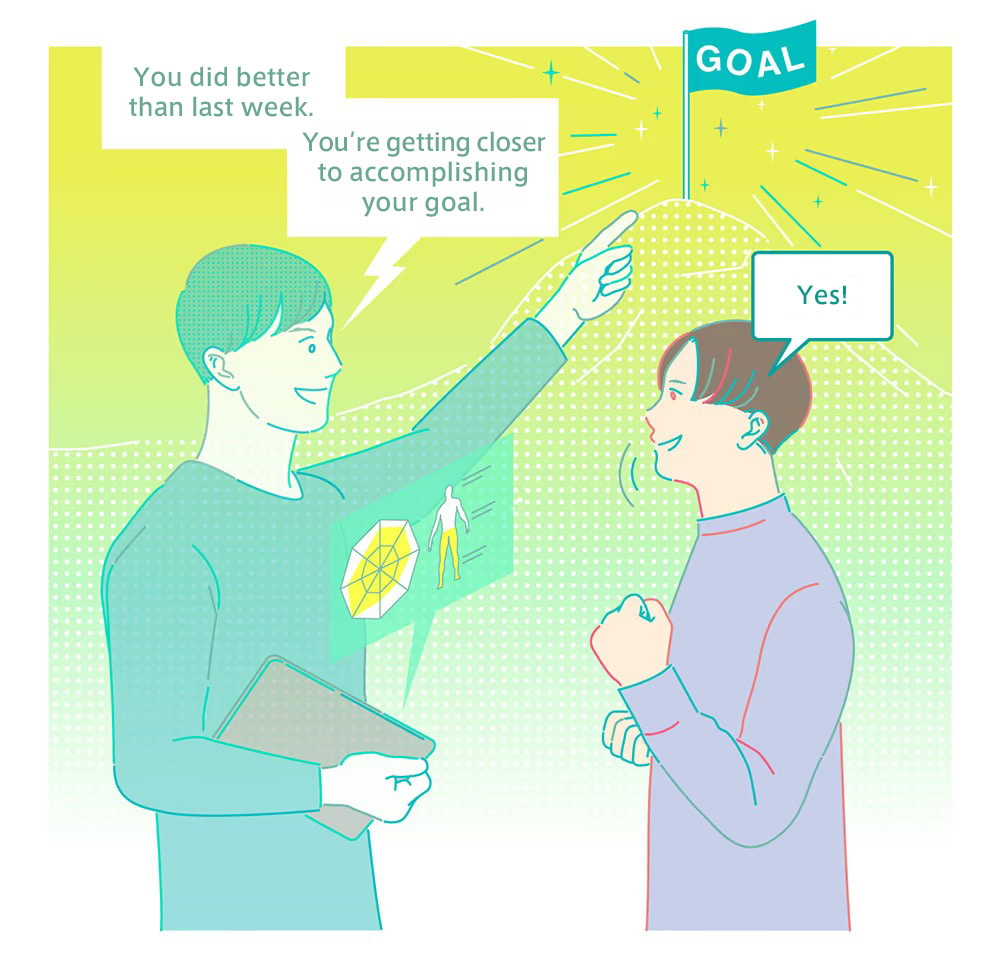
One of the proposals was to create a service that could function like a partner or coach to develop an ideal version of oneself. Such a service could analyze the user based on even more personal data than they are aware of, and guide them to goals aligned with their needs.
This idea stemmed from concerns among the students that pressure to make decisions entirely by themselves may increase in the future. As interaction with people become less frequent and activities are increasingly done online and remotely, there will be less assistance and advice coming from others.
At present, people can receive assistance when they don’t know what to do, and receive encouragement when they feel unable to act. Indeed, the students often spoke about their need for helpful advice and support. By proposing a tool for setting relevant goals and making progress to accomplish them, the students could focus on their efforts without any worries. Their desire to create such a future led to the following proposal.
Desired features of proposed service
- Analysis of user is based on more information than the user is aware of
- Goals are set
- Appointments are automatically booked and tasks set
Toppan technologies that triggered proposal
| Cheercle®: | App automatically collects a user’s health-related data via sensors and IoT devices; encourages user to adopt good health-related habits. |
Possibilities proposed by the students included having an app suggest actions suited to a user’s physical condition and mood on any given day.
| MetaClone®: | An app that can generate a simple 3D avatar of the user, using a camera or photo, and provide a variety of virtual experiences with the avatar. |
Possibilities proposed by the students included having the app provide a range of virtual experiences using the avatar.
Virtual supporter for each individual
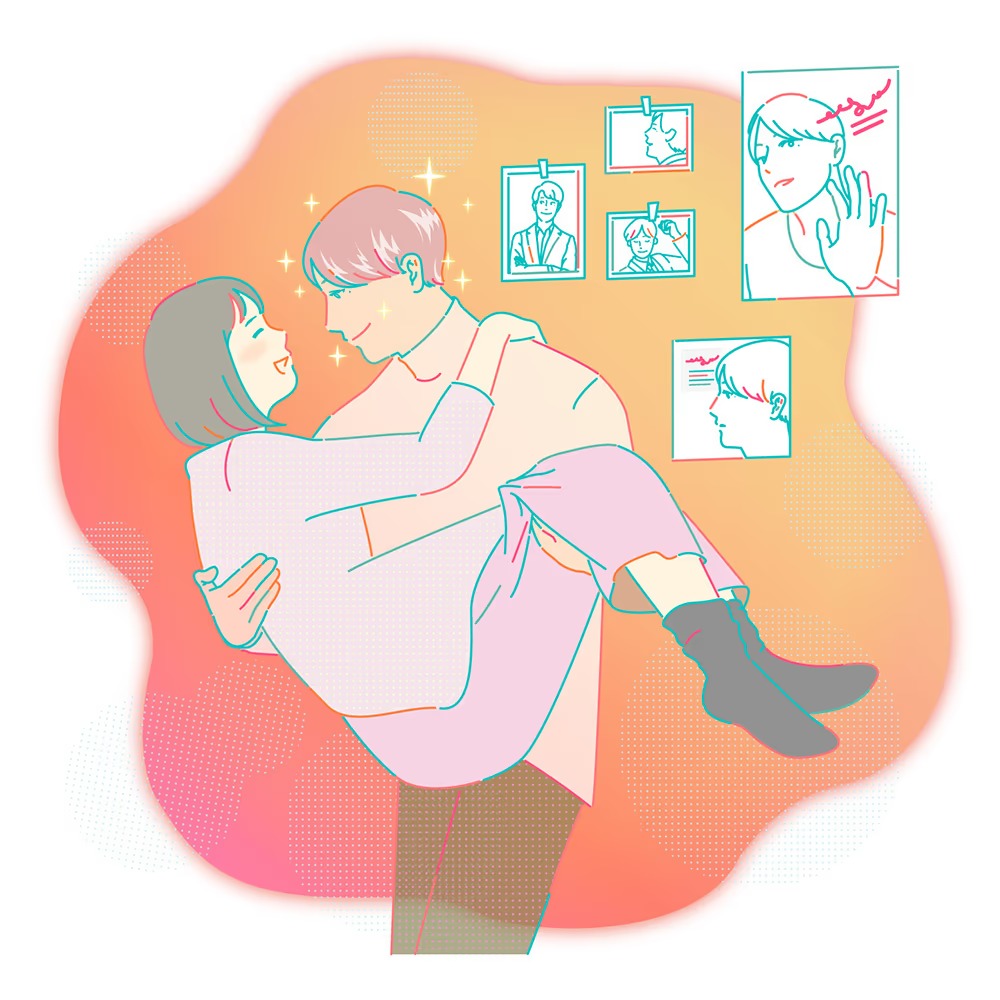
Another proposal was to create a service that could listen to and encourage a user, just like a loved one who always provides support at home. This idea reflected the students’ desire to be completely accepted by a supporter.
The proposal was made in the context of concerns among the students that they would have to vent their feelings and constantly rejuvenate themselves in the future because, as stress indicators are increasingly monitored digitally, people will be individually responsible for reducing their stress levels and staying motivated.
The proposal reflected their desire to face the world with excitement and a sense of security that comes from having a loved one in close proximity. The students said they hoped to create a future in which everyone has the ability to be and stay in good spirits, and to deal with daily life in their own way.
Desired features
- Advice offered; the user is listened to and encouraged
- Assistance with daily life and household tasks provided
- User’s ideal virtual person generated to make the user feel positive just by being together
Toppan technologies that triggered ideas for the proposals
| Virtual human: | An AI-generated virtual person can communicate naturally and learn about users through repeated interactions. |
Future possibilities proposed by the students included enabling the system to function like a close supporter.
| TransBots®: | A system that can remotely control robots and automatically coordinate the movements of multiple robots according to the spaces in which they operate. |
Future possibilities proposed by the students included having robots automatically perform household tasks.
Experiential platform for understanding different cultures and values
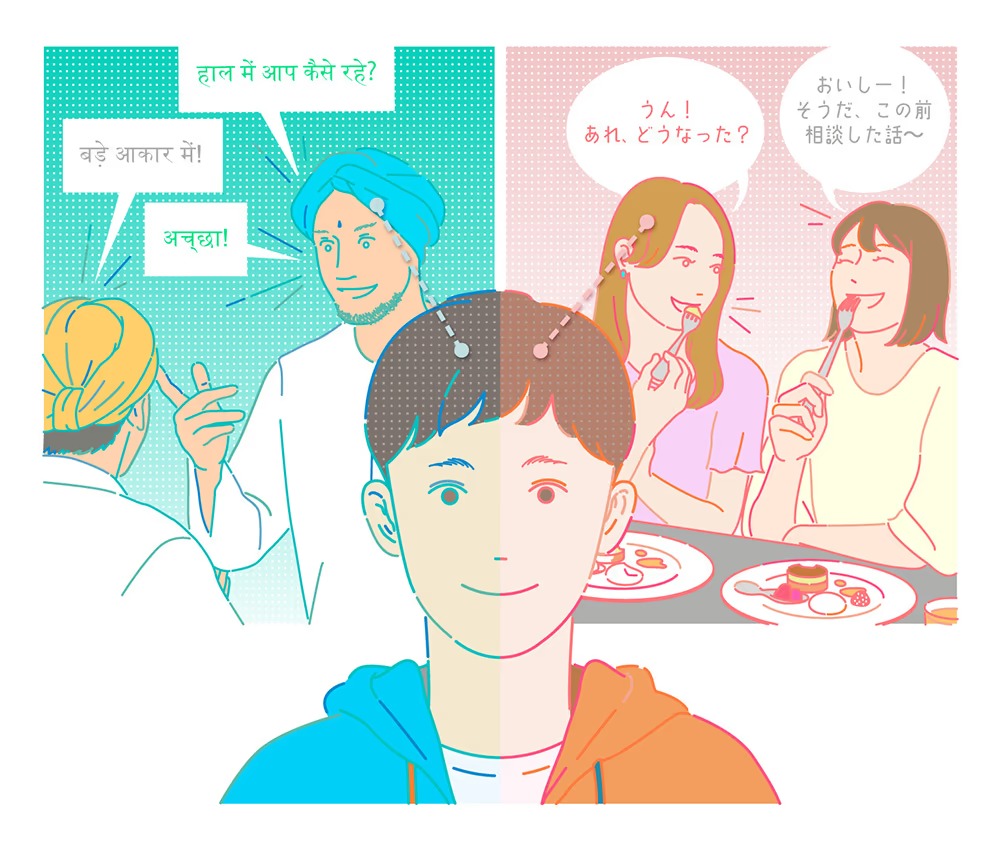
Another proposal was for a social media that could not only enable communication through language, but also facilitate a better mutual understanding of what users want to say by having the parties involved virtually experience each other’s cultural backgrounds and societies.
The idea for this proposal came from a desire among the students to communicate competently with people from around the world. Indeed, the students seemed aware that barriers between countries would gradually disappear, while opportunities for people to experience different cultures and ways of life were expected to increase.
Japan, being an island nation, offers only limited opportunities for cross-cultural communication. Nevertheless, the students indicated a desire to better understand and interact with people from different cultures and with ways of life. They seemed to sense that conflict in the world might be reduced were people to understand how others feel and think.
Desired features
- Users can virtually experience backgrounds, circumstances other users want to discuss
- Users can learn about world cultures, religions while in Japan
- Users alerted if their message has potential to offend recipients
Toppan technologies that triggered proposal
| GX Live™: | The app makes users in different places feel they’re in the same place. |
Possibilities proposed by students: Users in different places can interact in the same virtual space.
| MiraVerse®: | The virtual environment reproduces real-world settings by capturing colors and surface textures. |
Possibilities proposed by students: Experience of travel abroad without leaving home.
Personal AI counselor able to discuss anything
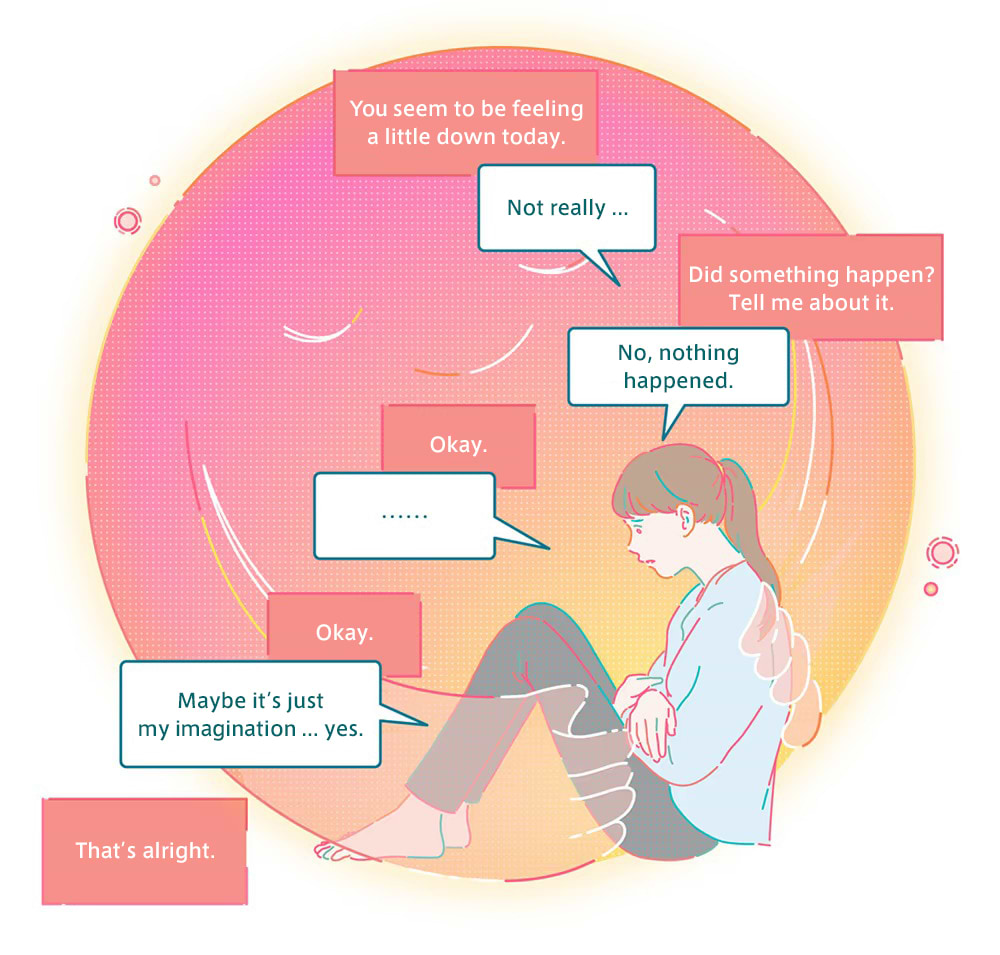
The students created a proposal for an AI counselling service that can discuss practically anything, including matters that users feel they cannot talk about with friends or family.
This idea shows that the students want match-making services and AI to evolve so that all people can engage with, and mutually understand, each other while feeling a sense of belonging.
Underlying this idea is their perceived need for ways of supporting people experiencing awkward relationships and struggling to determine what they truly want. That’s because these days, many people feel left behind, despite being able to make as many online connections as they want.
The proposal reflects the students’ hope that, in future, anyone feeling ashamed or having trouble talking about their problems can access counseling services and never feel isolated. Indeed, the ability to consult with a social media-facilitated system—be it AI-based or staffed by people—should be reassuring for everyone.
Desired features
- Advice available, user heard out anytime and anywhere
- Personal support given, all topics can be discussed
- User’s private information protected
Toppan technologies that triggered proposal
| Cheercle®: | The app automatically collects the user’s health-related data via sensors and IoT devices, and encourages the user to adopt good health-related habits. |
Future possibilities proposed by the students: Have the app give advice on mental health and dietary habits while monitoring the user’s physical health.
| Web3 Marketing Unit: | The service verifies the originality of digital artwork and content, distributes them, and helps fans manage communities free of misconduct. |
Possibilities proposed by the students: Have the service digitally verify that users have the required skills.
The workshop was originally intended to have students think about ideas for social media that could help spread happiness worldwide. However, their proposals went far beyond the scope and roles of the services at the time. We thus fine-tuned the ideas to bring their originality into sharper focus.
Concern about the future
While coming up with ideas together with the nine high school students in the workshop, we gained a real sense of their concerns about the future. We have summarized the worries and present them below, with some of the feedback we got from the students during the workshop.
The students’ first worry concerned the need to understand others. We identified their underlying anxiety about communication in the context of weakening interpersonal relationships and, in particular, whether they could reach a full and mutual understanding with others.
When people find it hard to express their feelings and to understand the thoughts and feelings of others, their stress is bound to grow if such interactions continue. Yet, if they avoid interacting with others for that reason, their ability to understand others may deteriorate. Recognizing this, the students expressed a desire to deeply understand the people they know. This really struck me.
The students’ second concern was about the endless pressure to make choices. With the diversification of online shopping and social media sites amid today’s information explosion, people are increasingly required to make choices. These range from trivial everyday matters to major decisions. I could see how the students needed help to recognize both what was really essential for them and how to avoid mistakes.
Finally, the students were concerned about their growing difficulty in understanding their own feelings and intentions. They said that, rather than choosing a job they wanted to do, they were inclined to choose based on their strengths and weaknesses. While job personalization is expected to become more common, the students indicated that besides doing what they are suited for, they believed that doing what they were meant to do was more important and would lead to greater well-being.
Many of the students told us that discussing their aspirations and the future they hoped to create was a new experience for them. Some were considering whether it would be worth their while and feasible to pursue some of the ideas they had discussed. This sparked the determination of workshop leaders to continue helping develop and inspire young people.
We compared the answers given to questionnaires distributed to the students before and after the workshop, and found a significant change in the tone of their answers.
For example, before the workshop, one student wrote: “The global environment will get worse, and while it can’t be restored, many measures will probably be taken by society to improve it.” After the workshop, the same student wrote—albeit it on another topic: “I think it’s good that technological advances are breaking down cultural, linguistic, and social barriers around the world.”
Although the positive outlook expressed by the student in an answer to the second questionnaire is due to the different topic, the detached, objective tone of the earlier response (“measures will probably be taken”) is in striking contrast to the more active, though modest, tone of the later response (“I think it’s good that...”). I sensed that this small difference could mark the beginning of a bigger change.
Nothing should prevent people from expressing their aspirations to do things. By having people envision and take steps toward a future that allows them to enjoy more freedom and independence, we hope to continue sharing ways of facing the years ahead.
By helping the students identify their concerns and envision the future they wanted to realize, we hope that the workshop sparked a shift in their mindsets. At least during the workshop they turned anxiety over the future into excitement about tomorrow, and felt motivated to work toward the future they aim for rather than wait for choices to present themselves.
Each of us can create an exciting future
By holding the workshop for the nine high school students, we alleviated their concerns about the future to some extent, while also giving them an opportunity to see what companies have to offer by learning about and considering the future potential of one manufacturer’s technologies and products.
Identifying how high school students think about their own future is very insightful from a marketing standpoint. The changes we observed in the workshop seemed to offer evidence that companies can take actions that influence young people’s decisions about what to study and what career to pursue.
At Mirai Jigyo Soken, we hope to work with companies that are interested in projects that seek to create a brighter future together with today’s youth, who will play a bigger role tomorrow.
A journey of a thousand miles begins with the first step. I feel keenly aware of this old saying when working on future-oriented projects. While this project may be modest in scope, it could eventually have a big impact if we keep building on it over the next decade. I will continue working on the project bearing that in mind.
We plan to create many more opportunities to tell everyone about our projects, so please stay tuned.
